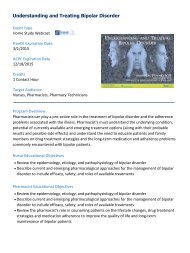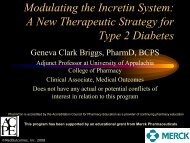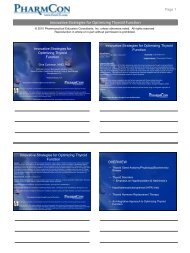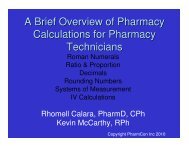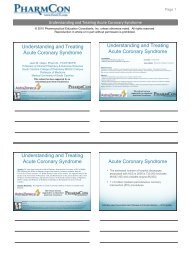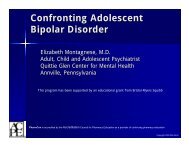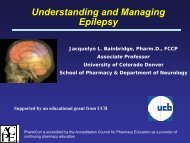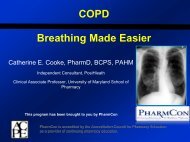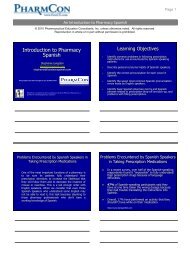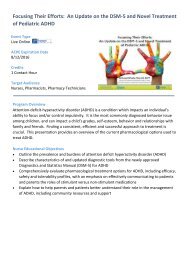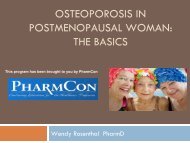Adherence - Free CE Continuing Education online pharmacy ...
Adherence - Free CE Continuing Education online pharmacy ...
Adherence - Free CE Continuing Education online pharmacy ...
- No tags were found...
You also want an ePaper? Increase the reach of your titles
YUMPU automatically turns print PDFs into web optimized ePapers that Google loves.
How You Can Make A DifferenceWendy Rosenthal, Pharm.D .This program has been brought to you by PharmConPharmCon is accredited by the Accreditation Council for Pharmacy<strong>Education</strong> as a provider of continuing <strong>pharmacy</strong> education.
Medication <strong>Adherence</strong>Speaker: Dr. Wendy Rosenthal, President of MedOutcomes, will be the presenter for thiswebcast. Wendy Munroe Rosenthal is the President of MedOutcomes, Inc. She received herDoctor of Pharmacy degree from the Medical University of South Carolina and her Bachelor ofScience in Pharmacy from the University of Georgia.Speaker Disclosure: Dr. Rosenthal has no actual or potential conflicts of interest inrelation to this programThis program has been brought to you by PharmConPharmCon is accredited by the accreditation counsel for Pharmacy<strong>Education</strong> as a provider of continuing <strong>pharmacy</strong> educationLegal Disclaimer: The material presented here does not necessarily reflectthe views of Pharmaceutical <strong>Education</strong> Consultants (PharmCon) or thecompanies that support educational programming. A qualified healthcareprofessional should always be consulted before using any therapeutic productdiscussed. Participants should verify all information and data before treatingpatients or employing any therapies described in this educational activity.
Medication <strong>Adherence</strong>Accreditation: Pharmacists-798-000-08-034-L04-PPharmacy Technicians -798-000-08-034-L04-TTarget Audience: Pharmacists & Technicians<strong>CE</strong> Credits:1.0 <strong>Continuing</strong> <strong>Education</strong> Hours or 0.1<strong>CE</strong>U for pharmacists/techniciansExpiration Date: 4/21/2011Program Overview: Medication nonadherence is a pervasive issue that threatenspatients’ outcomes and is very costly to the health care system. This program willexplore this complex concern and present some proven practical solutions.Objectives:1. Define the terms compliance, adherence, and persistence.2. Identify specific tactics pharmacists can use to improve medication adherenceThis program has been brought to you by PharmCon
<strong>Adherence</strong> vs. Compliance• <strong>Adherence</strong>: “the degree to which a person’sbehavior coincides with medical advice”• <strong>Adherence</strong> requires the patient’s agreement withthe recommendations• Compliance may suggest a passive approach bythe patient to health care
What is the most commontype of dosing error?1. Dose omission2. Extra dose taken3. Misscheduled dose
Patterns of <strong>Adherence</strong> to OnceDaily BP Meds• Examined data from 21 clinical studies with 4783 ptprescribed 1 once daily med for BP• <strong>Adherence</strong> determined using electronic bottles• At 1 yr, 50% stopped tx• On any given day, 10% of doses were missed• 95% missed single dose at least once yearly• 50% missed single dose once monthly• 50% took drug holidays for > 3 days at least onceyearlyBJM 2008May 17;336:1114.
How Much is Enough?•“Adequate <strong>Adherence</strong>”• Drug & disease dependent• Most researchers use 80%
Lets Look at the Numbers• 14% of all written prescriptions are never filled• 13% are filled but never taken• Chronic diseases:• <strong>Adherence</strong> drops most dramatically after first 6months• 50% drop out of treatment• Of those who continue, typical rates ofadherence are 50 to 60%
What are the Consequences?• Causes 125,000 deaths annually• 10% of hospital and 23% of nursing homeadmissions are linked to nonadherence• Nonadherence directly costs the US healthcare system $100 billion annually• Annual indirect costs exceed $1.5 billion inlost patient earnings and $50 billion in lostproductivityAm J Health‐Syst Pharm.2003;60:657‐65
<strong>Adherence</strong> Post MI Hospitalization•Evaluated 1521patient’s use of ASA,beta blockers &statins one monthpost hospitalization•Patients whodiscontinued use of allmedications had lower1 year survival (88.5%vs 97.7%) comparedwith those taking 1 ormore of the medication
<strong>Adherence</strong> Rates & BP Control• Retrospective evaluation of >10,000 pt withcoronary disease, followed a mean of 4.6 years• Investigated causes of treatment failures• 1/3 of cases: failure to intensify treatment• 1/3 of cases: medication nonadherence• 67% did not fill Rx despite therapy intensification• Conclusion: Importance of communicationbetween clinician & ptArch Intern Med.2008;168(3):271‐76
Evaluating <strong>Adherence</strong>• How accurate are physician’s estimates oftheir own patient’s adherence?1. 80%2. 75%3. 60%4. 50%
Evaluating <strong>Adherence</strong>• Pill Counts• Monitoring Pharmacy databases• Patient Self Report• Surrogate Markers
Five Dimensions of <strong>Adherence</strong>Health system Social/economicfactorsfactorsCondition related Therapy relatedfactorsfactorsPatient relatedfactors
Based on self report, what is the mostcommon reason patients gave for nottaking their medications as prescribed?1. Cost2.Forgetfulness3.Adverse side effects4.Not convinced of the need & value of thetherapy
Strategies to Improve<strong>Adherence</strong>•Therapy Related Interventions•Patient Related Interventions
Patient Case: Mrs. Gotta Lower• 67 yo postmenopausal female• Problem list: none• Meds:• ASA daily• calcium supplement• Baseline labs:• Total cholesterol = 270 mg/dL• TG = 140 mg/dL (goal < 150 mg/dL)• LDL‐C = 210 mg/dL (goal < 160 mg/dL)• HDL‐C = 38 mg/dL (goal > 50 mg/dL)• Plan: Diet changes & exercise
Follow‐up VisitBaselineTC (mg/dL) 270 250TG (mg/dL) 140 130Diet &ExerciseRX:Pravastatin 20mgI qd#30LDL‐C (mg/dL) 210 189HDL‐C (mg/dL) 38 40
Possible Reasons for Lack ofResponse• Wrong diagnosis• Inadequate dose• Nonadherence with diet &/or exercise• Erroneous lab result• Drug interaction• Nonadherence with medication
Determine Degree of <strong>Adherence</strong>•Patient self‐report•Lab results & physical assessment•Pharmacy refill & appointment records
Which of the following questions islikely to elicit a honest response?1. You are taking all of your pills, aren’t you?2. Many people have difficulty taking theirmedications as prescribed. Do you have anyproblems taking your meds?3. I know it is very difficult to remember to takemedications on a daily basis. How often did youforget to take your (specific drug name) last week?
Patient Case: Mrs. Gotta Lower• “I know I took it thismorning & yesterday.”• Medication PossessionRatio (MPR) = 51%• Lab results
Identify Causes of Nonadherence•Readiness for behavioral change•Support for behavioral change
Readiness for Behavioral Change• Recognize there is a problem• Believe the medical condition to be serious• Believe the medication will help correct theproblem• Understand how to use the medication
WHAT YOUR PATIENT TELLS YOUWHAT YOUR PATIENTDOESN’T TELL YOUFull extent of adverse effectsLifestyle concernsConfusion and memory problemsDisabilitiesDoubts and fears
Look For Resistance• How confident are you that this medication willhelp you?• What is your understanding of theconsequences of not treating your (diseasestate)?• What is your overall goal in using thismedication?
Elicit Patient’s Thoughts• Are you experiencing any problems taking yourmedication?• Does your medication make you feel bad in anyway?Patient Case: Mrs. Gotta Lower• “My sister had troublesleeping when she tookthis medication. I don’tneed that.”
What % of patients reported not takingtheir medications due to concernsabout ADRs?1. 10%2. 25%3. 45%4. 50%
Minimize the Impact of AdverseEffects• Educate patients about the most commonadverse effects associated with themedication• Inform patients if adverse effects do occurit is usually possible to modify therapy toeliminate or avoid the unintended effects
Patient Case: Mrs. Gotta Lower•Determine if patient isactually experiencingsymptom•Evaluate likelihood ofmedication being thecause
Tools to Support BehavioralChange•Patient specific education based onidentified gaps in knowledge base
True or False?Once I tell my patients it is theright thing to do, they willadhere to their medications asprescribed.
Tools to Support BehavioralChange•Simplify the regimen• <strong>Adherence</strong> declines significantly as the dosingfrequency exceeds twice a day• Combination products reduce the number ofdoses per day as well as patient copayments• Ensure patient is on fewest medicationspossible•Match administration times topatient’s activities of daily living
<strong>Adherence</strong> to Once Daily BP Meds• Examined data from 21 clinical studies with4783 pt prescribed 1 once daily med for BP• Missed doses were more common betweenApril & Sept & on weekends• Morning takers significantly more likely toadhere than evening takersBJM 2008May 17;336:1114.
“Tell me about your daily routine”• When do you eat, when do you get up, and go tobed ?• What other activities you perform an a dailybasis?• How much variation is there in your routine fromday to day?• How does your weekday routine compare to yourweekend routine?• When do you think you are most likely to takeyour medications? What will work best for you?
Tools to Support BehavioralChange• Dosing Reminders• Visual cues• Pill boxes / organizers• Mark the calendar or PDA• Computer pop‐ups or alarms‣ Remindermed.com‣ Rxnotify.com• Vigilance effect
Tools to Support BehavioralChange•Reinforcement and Rewards• Routine reports on progress• Ongoing reinforcement of the importance ofadherence• Praise
Elicit Patient’s Thoughts• Tell me your medication schedule.• How do you remember to take yourmedication?• How is this working for you?
Implement Action Plan•Patient educationconcerning ADRs•Use of pill boxorganizer•Place in triggerlocation•Ongoing interaction& follow up
<strong>Adherence</strong> Related Research• Most of the studies had small numbers of patientsand lacked power to detect clinically importanteffects• Most studies assessing complex interventions didnot assess the separate effects of the components• Often the interventions were not adequatelydescribed• The follow‐up period was relatively short‐term• Few studies examined major clinical end points
FAME Trial• Goal: effect of <strong>pharmacy</strong> intervention program onadherence among elderly with > 4 chronic meds• Intervention: medication education, RPh follow‐up& customized blister packs• Design:• Run‐in phase: 2 months, baseline adherence, LDL & BP• Phase 1: 6 months, intervention for all patients• Phase 2: randomized to either continued interventionor return to usual careJAMA.2006;296:2563‐2571.
FAME Trial• Results:• Run‐in phase:• Mean adherence was 61.2%• Phase 1:• <strong>Adherence</strong> increased 35.5% over baseline• 16 fold increase in patients > / = 80% adherent to all meds• Mean SBP changed from 133.2 mmHg to 129.9 mmHg• Mean DBP changed from 70.5 mmHg to 69.7 mmHg• Mean LDL changed from 91.7 mg/dL to 86.9 mg/dL• Phase 2:• Mean adherence maintained in intervention arm• Declined in usual care arm
Electronic Communications &Home BP Monitoring• Goal: Determine if pt Web services, home BP monitoring& RPh‐assisted care improves BP control• Intervention:• Group 1 : usual care• Group 2: home BP monitoring + Web services• Group 3: home BP + Web services + RPh care via Web• Results:• Group 2 had nonsignificant increase in % pt with controlledBP• Group 3 had 25% more pt with controlled BPJAMA 2008;299(24):2857‐67.
To reap the benefits of modernmedical therapies, better, moreeffective, and more efficientinterventions for helping peoplefollow regimens are needed.



